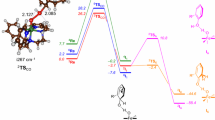Abstract
This article tries to rationalize the shortcomings of various model compounds and discusses requirements that a low-molecular compound must fulfill in order to become a potentially competitive catalyst for nitrogenases. For fundamental reasons, such a synthetic catalyst cannot be a precise structural duplicate of the active centers of nitrogenase. Results obtained with iron-sulfur carbonyl and diazene complexes further indicate that (1) the coupling and chronology of proton and electron transfer steps, (2) invariance of iron-sulfur distances within a wide range of electron density changes at the iron centers, and (3) Brönsted basic thiolate donors favoring the protonation of metal-sulfur cores and the formation of N–H···S bridges may be essential in order to reduce N2 via N2H2 and N2H4 to NH3 under mild conditions.
Similar content being viewed by others
Author information
Authors and Affiliations
Additional information
Received and accepted: 21 August 1996
Rights and permissions
About this article
Cite this article
Sellmann, D., Sutter, J. Elementary reactions, structure-function relationships, and the potential relevance of low molecular weight metal-sulfur ligand complexes to biological N2 fixation. JBIC 1, 587–593 (1996). https://doi.org/10.1007/s007750050097
Issue Date:
DOI: https://doi.org/10.1007/s007750050097




